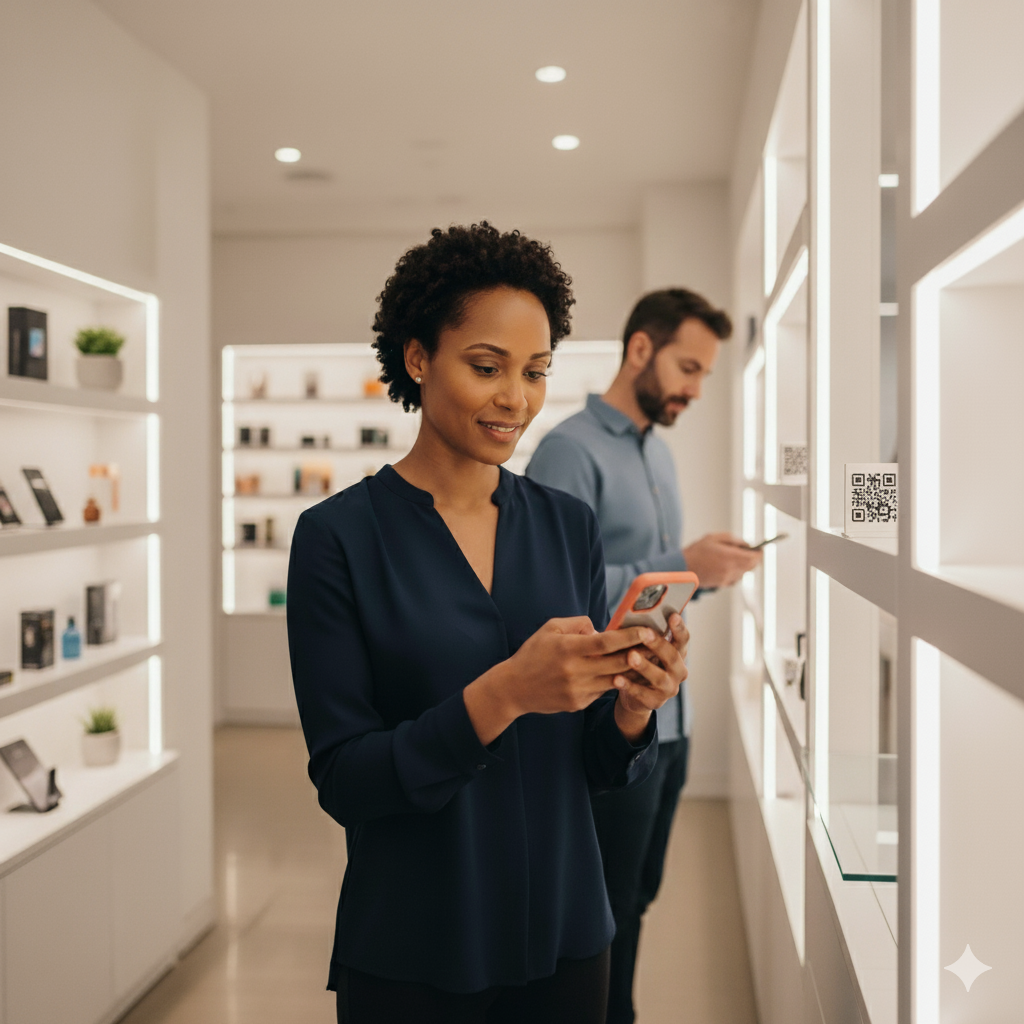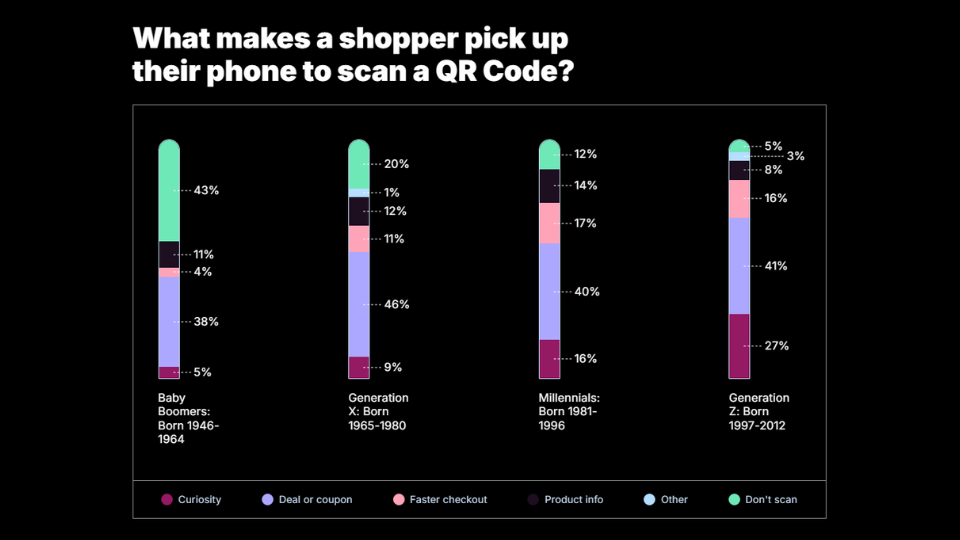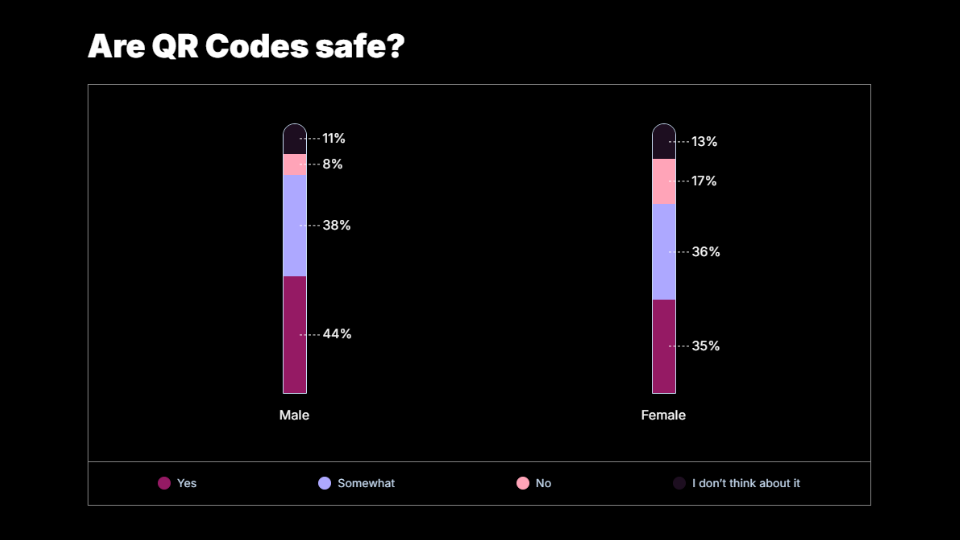The Psychology Behind What Makes BFCM Shoppers Scan and Stay

Every Black Friday Cyber Monday (BFCM), brands deploy QR Codes everywhere, generating impressive scan rates and weekend revenue spikes. But by January, most of those "new customers" have vanished.
The problem isn't with the QR Code technology but with understanding the psychology behind why people scan.
Uniqode's BFCM QR Code Marketing Report reveals the critical gap between holiday QR Code engagement and long-term loyalty building.
While 74% of shoppers will scan QR Codes during BFCM, and 72% of marketers rate their campaigns as effective, few brands successfully transition these quick digital interactions into lasting customer relationships.
The solution lies in understanding what really drives shoppers to scan during the holiday frenzy and how to design QR Code experiences that satisfy both their immediate urgency and their deeper value needs.
The urgency & FOMO effects that rule BFCM
Holiday mega-sales spark urgency like nothing else. Countdown timers and banners flashing “limited stock” flip a switch in shoppers’ minds, turning a gadget into a now-or-never buy. This is FOMO psychology at its peak.
- Scarcity triggers loss aversion: "Only 2 left at this price" drives immediate action
- Time pressure overrides deliberation: Shoppers act first, rationalize later
- Competition creates excitement: Beating others to the deal feels like winning
QR Codes amplify this urgency perfectly. A shopper sees "Scan now for exclusive 2-hour deal" on a store display or Instagram story, and that instant access creates irresistible momentum.
The QR Code opportunity is significant: Recent research surveying 1,000 U.S. consumers shows 74% of shoppers are likely to scan QR Codes during BFCM, with Millennials and Gen Z leading adoption of these interactive shopping tools.

The balancing act as a marketer is to use this urgency ethically by highlighting genuine scarcity and real deadlines while ensuring the post-click experience delivers on the promise that drove the initial action.
But urgency alone won't bring shoppers back in February. That requires understanding what motivates them beyond the clock.
Discounts vs. long-term value
Discounts are BFCM's primary traffic driver.
61% of marketers rely on percentage-off promotions, and over half of QR Code users expect immediate offers and discounts when they scan.

The psychology is straightforward: deals trigger dopamine hits and create irresistible shopping momentum.
But here's the critical distinction: While discounts drive BFCM scan behavior, perceived value drives loyalty.
Outside the holiday rush, shoppers slow down. They compare features, read reviews, and think carefully. They ask: “Is this product worth it even without a discount?” or “Will this brand deliver quality and service?”
This is where perceived value matters. Superior product quality, convenience, or a smooth customer experience make people stick around long after the sale.
So what’s the takeaway?
- Use discounts strategically: BFCM is when people expect them, but don’t make discounts your only tactic.
- Deliver full value: Make sure the product lives up to the promise and gives them a trustworthy experience.
- Think long-term: When customers feel they scored a bargain and got a great product, they’ll return even when the discounts are gone.
Now, here's something most marketers overlook in the BFCM chaos: none of this matters if shoppers don't trust you in the first place.
Trust as the silent loyalty driver
In the frenzy of holiday marketing for sales, trust is often the quiet factor determining whether a shopper buys or will buy again. Flash deals can grab attention, but people gravitate to safe and reliable brands when everything feels overwhelming.
Trust manifests in crucial micro-moments:
- Believing the deal is genuine, not a bait-and-switch.
- Knowing the product will be as advertised.
- Feeling secure when scanning a QR Code or making a payment.
According to Uniqode’s BFCM QR Code Marketing Report, 37% of shoppers remain on the fence about whether QR Code interactions are safe. That “neutral middle” means plenty can be won—or lost—based on how you design the experience. For deeper shopper behavior insights during BFCM from the report, see how scanning habits and trust perceptions differ across generations and demographics.

A QR Code should never feel like a gamble. The same goes for your emails, landing pages, and checkout flow. If anything feels sketchy, shoppers will bounce, no matter how big the discount.
The payoff of trust is loyalty. Customers who believe in you are less likely to chase the next lowest price because they know the experience with you will be positive. But trust isn’t uniform across demographics.
For example, Baby Boomers showed the least confidence in QR Code offers; many either distrust them or haven’t formed an opinion. You’ll need extra reassurance to win them over: clear guarantees, familiar channels, and guidance that makes them feel secure.
Bottom line: Discounts may drive the click, but trust drives the repeat purchase.
Of course, building trust looks different depending on who's scanning your QR Code.
Demographics that tailor your loyalty strategy
Not all holiday shoppers behave the same way. Different groups bring their own habits, expectations, and loyalty drivers to BFCM. Let’s look at what the data shows:
Generational differences
Millennials and Gen Z (Digital natives)
- Nearly 50% very likely to scan QR Codes during BFCM
- Respond to interactive, mobile-first campaigns
- Loyalty tactic: FOMO-driven campaigns, social exclusives, gamified experiences
Gen X (Cautious adopters)
- 26% very likely to scan, 43% likely with a clear value proposition
- Loyalty tactic: Straightforward value communication, less complexity
Baby Boomers (Traditionalists)
- Only 7% very likely to scan codes
- Prefer familiar channels and simple processes
- Loyalty tactic: Email offers, phone orders, in-store experiences
Gender nuances
Both men and women are open to deal-scanning, but the split is telling:
- Men show slightly higher enthusiasm, with 44% believing QR Codes are safe.
- Women are more cautious. 36% and 17% said they could be somewhat and totally unsafe, respectively.
- For women, trust and safety messaging is essential.

Other factors: geography & income
- Region: Shoppers in the U.S. Northeast showed the highest interest in scanning (42% very likely), suggesting more comfort with tech-driven shopping. In regions like the Midwest, BFCM campaigns may need to focus more on reassurance and value-first messaging.
- Income: Shoppers engage across all income brackets. 37% of those with income above $50,000 are highly likely to scan, versus 25% of those with income below $50,000. Once scanned, the first group often expects product details, while the second looks for discounts and offers.
These demographics remind us that building consumer loyalty isn’t one-size-fits-all.
A Gen Z shopper who finds you on TikTok might need playful social engagement afterward. A Boomer who tries your store because of a coupon might prefer a clear, friendly email outlining how to save more next time. Each slice of your audience needs a slightly different recipe, but they will most likely stay when they feel seen.
So how do you actually apply these psychological insights to your BFCM campaigns?
What marketers can do
By now, we’ve identified the significant forces shaping loyalty during BFCM: Urgency, discounts vs. value, trust, and demographics.
But how do you put this into action?
1. Start early, test everything
Shoppers start hunting for deals long before Black Friday, so your marketing must start early, too. Tease offers, test QR Code placements, and gather scan data weeks in advance. This way, you’ll refine your messaging and channels ahead of time instead of scrambling to put things together in the final 48 hours.
2. Design frictionless QR Code journeys
QR Codes don’t work like gimmicks. While 74% of consumers said they were likely to scan during BFCM, 35% reported frustration with broken or slow scans. Every dead link erodes trust. Keep scans instant, mobile-friendly, and directly tied to intent: a promo code, product demo, or fast checkout.
3. Match medium to audience
BFCM shoppers are not only online, but also in stores, walking on streets with billboards, and flipping through flyers. Use QR Codes on packaging to upsell, on signage to push urgency (53% of consumers will likely engage with this), and on social posts to drive immediacy. The key is matching placement to the behavior of your target demographic.
4. Measure beyond revenue
Sales spikes look good, but they don’t prove loyalty. Although 57% of marketers chose revenue as their top metric, you can track repeat scans, redeemed offers, and other impressions as they contribute to more sales. Remember that 17% of shoppers are more likely to scan to join a rewards program during BFCM, making it the perfect moment to capture long-term loyalty.
Execute these strategies well, and you'll be positioned for the ultimate goal: long-term loyalty. Also, learn how QR Codes help shoppers share and advocate, turning loyalty into genuine brand love.
Building customer loyalty beyond the sale
BFCM's psychological drivers (urgency, value-seeking, and trust-building) create a unique window for customer acquisition. But the real opportunity lies in transforming holiday shoppers into year-round advocates.
The winning formula is to meet customers in their FOMO moment with compelling offers, deliver exceptional value that exceeds expectations, and build trust through consistent, personalized experiences.
Success comes from designing QR Code-driven, omnichannel experiences that match diverse shopper needs while building the foundation for relationships that last well beyond December.
To put these psychological insights into action, explore how leading brands optimize QR Code experiences for conversions during BFCM.
Don't let your BFCM customers vanish by January! Discover exactly how to design QR Code experiences that convert holiday shoppers into year-round advocates with Uniqode’s QR Code Marketing Guide for BFCM.
